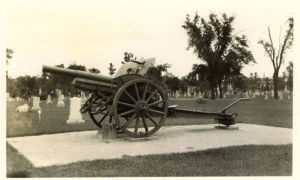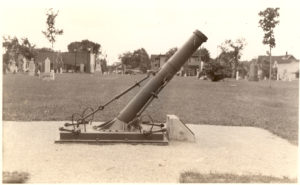Tales from Pioneers and Soldiers Memorial Cemetery
By Sue Hunter Weir

In the 1890s Congress passed legislation allowing a number of organizations to apply for military surplus equipment. This “decorative” cannon and mortar were placed in the cemetery in the1920s and removed during World War II ”“ they were most likely used for scrap.
162nd in a Series
Albert Nelson, caretaker at Minneapolis Pioneers and Soldiers Cemetery from 1927 until his death in 1953, had a keen awareness of the role than many in the cemetery played in the state and city”'s history. It seems unlikely that he had any idea about his own role in that story. He had intended to write a book about the cemetery, but it appears that he ran out of time. Nonetheless, he left us an amazing amount of information that Mike Barth, current caretaker, found in one of the cemetery”'s ancient file cabinets. Â
The file contains Mr. Nelson”'s monthly reports to his supervisor between January 1939 and March 1944. There are 95 pages, carbon copies, most no more than one or two pages long. In addition to reporting on routine maintenance tasks ”“ mowing, raking, shoveling, etc. ”“ he provided important information about many monuments, tree plantings, memorial and dedication programs, burials and removals. H e answered a question that we have often wondered about ”“ who built the addition to the caretaker”'s cottage and when?
e answered a question that we have often wondered about ”“ who built the addition to the caretaker”'s cottage and when?
The original building, built in 1871, consisted of two rooms. Nelson first mentioned the addition, a “tool house,” in June 1939. The men who worked on it were employees of the Work Projects Administration, a program created by the Roosevelt administration to combat unemployment during the Depression. Work progressed slowly, interrupted by funding shortfalls and a nation-wide labor strike in 1939 when hundreds of thousands of workers walked off their jobs to protest a cut in wages. Masons, stonecutters, and carpenters stayed off the job until October. When they returned carpenters cut an opening that connected what is now the middle room and the back room. The addition was completed in July 1940.
There were 19 burials between 1938 and early 1944; most were widows in their 70s or 80s. One of the most interesting pieces of information that Mr. Nelson provided was about the family of Katherine Smith. Mrs. Smith was the mother of Lafayette Mason, a South High football star, a professional pianist, and one of the city”'s earliest African-American firefighters who in 1910 died at the age of 29 and was buried in the family”'s plot. Mr. Nelson described Mrs. Smith”'s 1941 funeral as “ a very large funeral,” and noted that she was buried near her grandmother, father, and mother “all born slaves.” Her father, Morgan Jones, at 101 years old, is the oldest person buried in the cemetery. His story appeared in the Alley in December 2017 (https://alleynews.org/?s=morgan+jones).
Then, as now, people seemed to have been prone to driving into the fence. On April 21, 1938, a car or truck crashed into a section of fence. The fence was repaired but in February 1940, another section of the fence was knocked down. Fortunately those drivers hit the chain link rather than the decorative steel and limestone fence.
And the turnaround at the end of the cemetery”'s only road posed a problem for at least one driver whose car “pinched its wheels on the outside curb.” The driver stepped on the gas, jumped the curb on the other side of the loop and crashed into a tree. The result according to Mr. Nelson was “a bent bumper, broken headlight and small dent in the fender. A little bark was loosened from the tree.”
Cars weren”'t the only potential hazard to the cemetery. In October 1941, a horse got into the cemetery where a section of fence had been removed. Nelson and the horse had to stay in the cemetery until the horse”'s owner was found. The following month, a different horse got into the cemetery but, according to Nelson, it “was a very old horse and no damage was done.”
Mr. Nelson frequently reported that friends and family members of those buried in the cemetery came to visit. In September 1938, James Needles traveled from Honolulu, Hawaii, to visit the unmarked grave of his father, Joseph Nettles, a Civil War veteran who had died in 1890. Four years later Joseph Needles had a military marker placed on his grave.
Not all visitors came to visit graves. In April 1938, Nelson “”¦played nurse to a lost baby boy”¦for two hours until the mother and police came for him.” Nelson wrote his funniest comment in July 1941: “I had to request a young woman who mistook the cemetery for a nudist camp to leave the grounds. She was sober and good looking but had a very bad temper.”
Some of his workdays were just more interesting than others.









